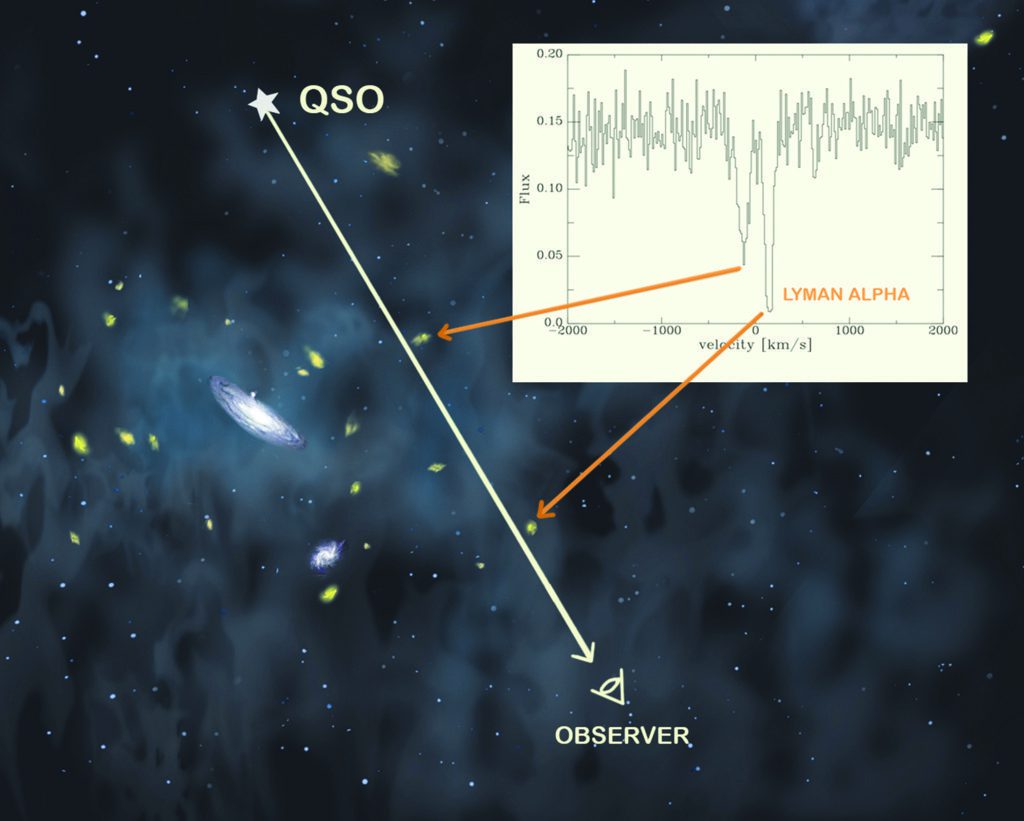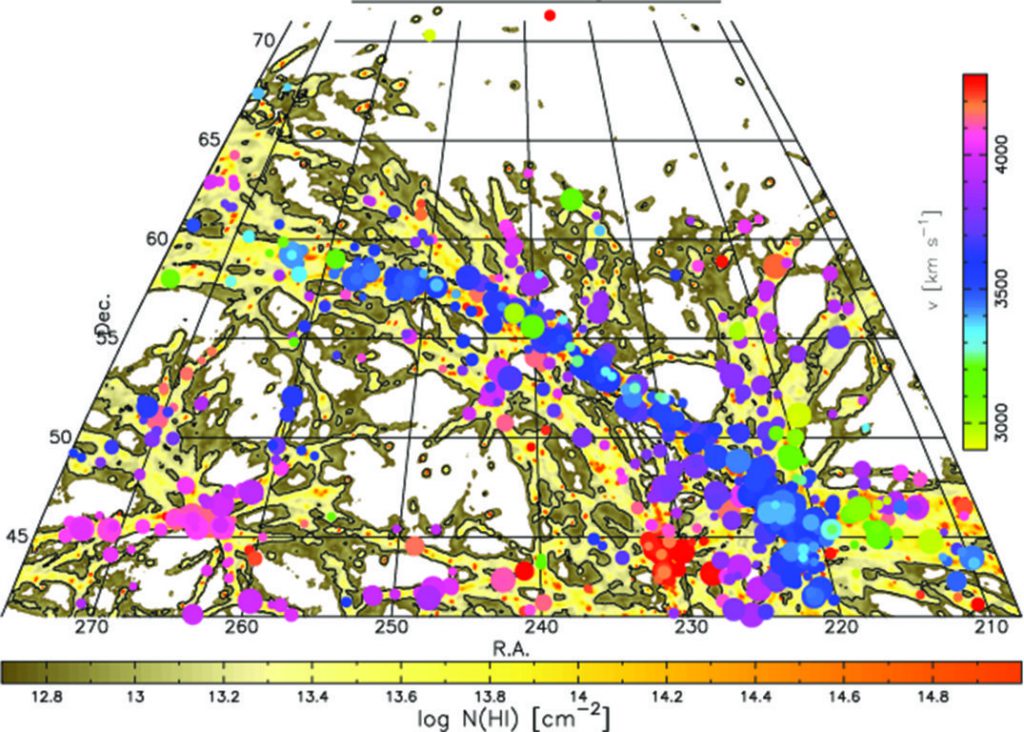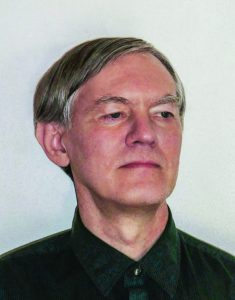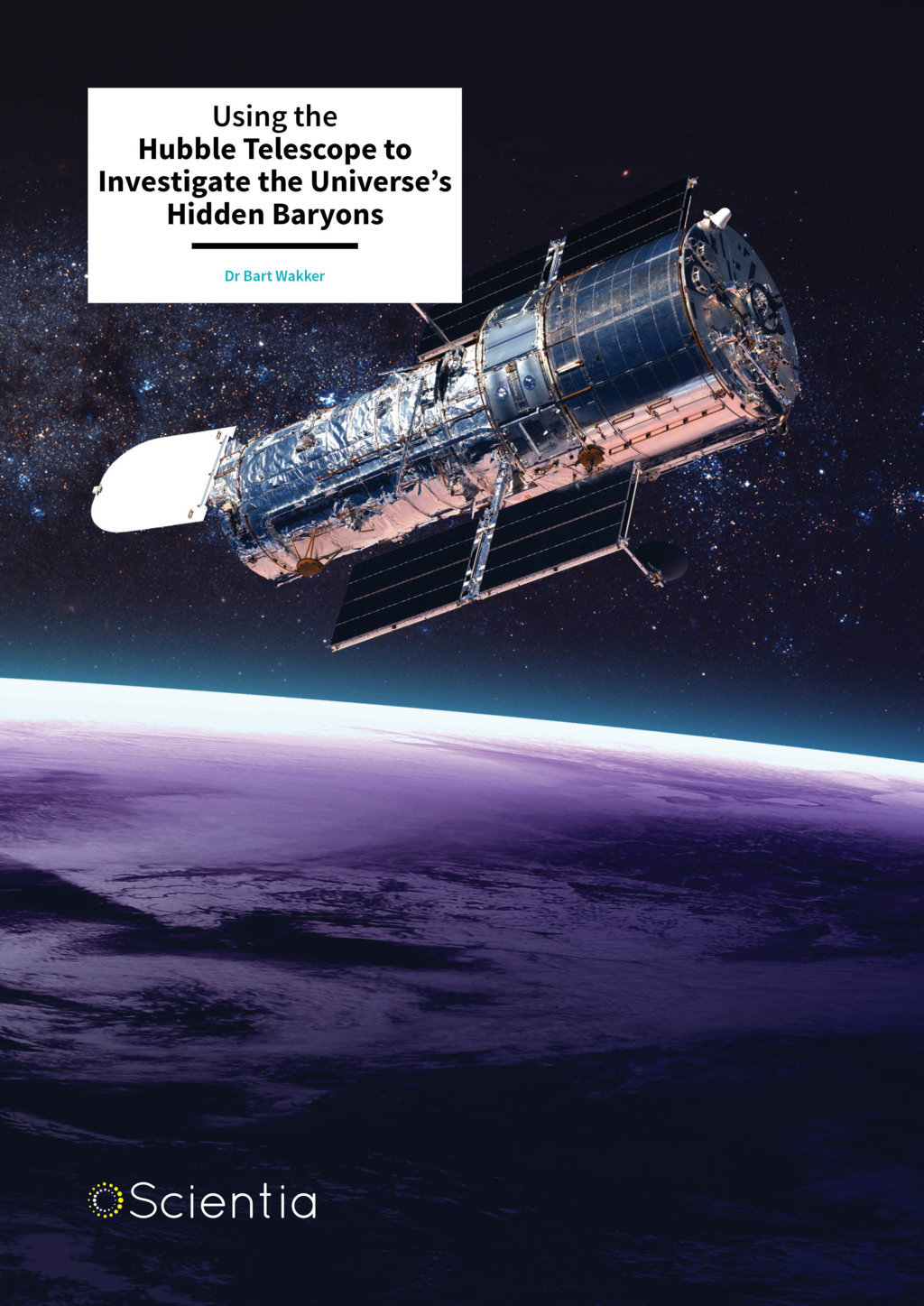Dr Bart Wakker – Using the Hubble Telescope to Investigate the Universe’s Hidden Baryons
Astronomer Dr Bart Wakker and his colleagues use the Hubble Space Telescope (HST) to gather data on hidden baryonic matter and the composition of the Universe.
Getting Closer to Far, Far Away
From the era of Galileo and Copernicus up until now, our knowledge of space has primarily been obtained visually – by looking at the skies with the naked eye or with an ever-improving array of telescopes. Today, in order to avoid some of the haze and interference of Earth’s lower atmosphere, astronomers set up observatories and telescopes on high mountains. Even better still, we’ve now set up our most modern telescopes high above the Earth, in orbit. This completely avoids interference from the Earth’s atmosphere and gives a much clearer view of the rest of the Universe. But that only lets us see better what we can see – what’s visible to our telescopes.
The well-known Hubble Space Telescope, for example, is in low Earth orbit at an altitude of about 540 km, obtaining highresolution pictures and spectra of the cosmos by collecting near-infrared, visible and ultraviolet radiation emitted by stars and other galactic objects. However, much matter in the universe does not emit radiation, visible or otherwise. This is where Dr Wakker and his colleagues, Drs Taesun Kim, Blair Savage, Audra Hernandez and David French, all at the University of Wisconsin-Madison, have been doing some out-of-the-box thinking in using the Hubble Telescope to scope out the Universe. By visualising the invisible, they are trying to understand the flows of gas between the intergalactic and circumgalactic medium around galaxies, to determine how galaxies obtain gas needed for star formation.
How Do You Visualise Something That’s Invisible?
When someone brings up the topic of galaxies, the first thing that comes to mind is the Milky Way, our own neighbourhood of stars, gas and dust that stretches about 100,000 light years across. And then there’s the Andromeda galaxy, one of the Milky Way’s nearest neighbours. In fact, we generally think of our Universe as composed of individual, discrete collections of stars or galaxies with lots of empty space in between. This is quite incorrect, however. In recent decades, astronomers have determined that galaxies represent just a small fraction of the contents of the Universe.
The so-called ‘empty space’ between galaxies still contains matter, though not in a state that emits light we can see through usual methods. So, what is this matter that we can’t see and how do we even know it’s there? Because of the way that the Universe appears to be constructed, scientists can calculate the total amount of energy needed to make the universe behave the way they observe it – the way the stars and galaxies move and interact. But the matter we can actually see isn’t nearly enough to contain that amount of energy. This is where socalled ‘dark matter’ and ‘dark energy’ come in. From calculations and observations astronomers and cosmologists believe that over 70% of the required energy to ‘run’ the Universe is ‘dark energy’. So far, we don’t know what produces dark energy. Perhaps it’s some sort of ‘tension’ in space, or something other yet-unexplained function of space-time. More than that, another quarter of the Universe’s energy resides in ‘dark matter’, an unknown particle that does not interact with electromagnetic fields, weakforce fields, or strong-force fields.

A 100 x 100 Mpc slice through a simulation of the universe. From the EAGLE project by Schaye et al. (2015, MNRAS 446, 521).
Finally, only 4% of the total energy exists as ‘baryonic matter’ – mainly normal protons and neutrons. There are also many lighter electrons and a miniscule amount of more massive atomic nuclei and atoms, but these do not contribute significantly to the mass. And of this 4% baryonic matter, Dr Wakker tells us that just 10% resides inside galaxies and galaxy clusters, representing only 0.4% of the universe’s energy. This 0.4% is what emits the light that we can study directly. However, the remaining 90% of baryonic matter, representing around 3.6% of the universe’s total energy, exists outside galaxies. This is what Dr Wakker and his colleagues are interested in.
‘Normal matter is the only thing we can observe directly, so the existence of dark matter and dark energy is derived from its motions,’ Dr Wakker tells Scientia. ‘What is less well known, even to many professional astronomers, is that of that 4% of the gravitational energy of the universe that is made of normal matter, only about 10% is actually inside galaxies.’ It turns out that galaxies are just the regions of space where the matter has concentrated enough to form stars. After all, stars emit light – electromagnetic radiation – so we can see them.

Illustration of the method used to find the intergalactic gas. Light from a quasar (QSO) passes through the tenuous ionised gas surrounding a galaxy. Near denser concentrations of the gas (the yellowish blobs), some of the gas contains sufficient neutral hydrogen to produce the Lyman alpha absorption line in the spectrum.
Astronomers now think that galaxies form near concentrations of dark matter, which was first proposed by the Swiss astronomer Fritz Zwicky in the 1930s and observationally confirmed by Vera Rubin and collaborators in the 1970s. Dark matter is a crucial ingredient in cosmological hydrodynamic simulations – computer computations that analyse the motions of visible astronomical objects and calculate what the motion means in terms of the gravitational fields that are in play causing the motion. In such simulations, the universe starts out mostly uniform after the big bang, but small density fluctuations cause dark matter to aggregate into clumps and filaments, forming what is called the ‘Cosmic Web’. The dark matter pulls on the normal matter. But while dark matter only feels gravity and forms centrally-condensed clumps, the normal matter undergoes friction, and not all of it can fall into those clumps. The small fraction that does forms the visible galaxies. Probably about half of the invisible baryonic matter (the protons and neutrons) is in the circumgalactic medium, the region of space near galaxies where there are very few stars. In fact, Dr Wakker has done research to show that it can stretch out to as far as 300 kiloparsecs (about 1 million lightyears). In addition, he has provided evidence that the other half is indeed associated with the Cosmic Web, rather than individual galaxies.
So how do we visualise something invisible? Dr Wakker says we can look at its shadow, so to speak. Some of this matter absorbs light emitted from galaxies behind them, and does so at a characteristic wavelength of ultraviolet radiation. This signature absorption allows us to see them basically as shadows in space, absorbing radiation from quasars and stars behind them. The most prominent absorption line is the hydrogen Lyman alpha line, corresponding to a neutral hydrogen atom in the ground state absorbing an ultraviolet photon with a wavelength of 121.5 nm. In intergalactic space, there is a balance between protons finding an electron and forming a neutral hydrogen atom, and ultraviolet photons ionising those atoms. The combination of gas density and radiation intensity is such that only about one hydrogen atom in a thousand to one in a million is neutral. But because there is so much hydrogen, this is sufficient to cause an observable feature in the spectrum that we can measure. This is where Dr Wakker has been concentrating his efforts.
Looking for Hidden Matter Between Galaxies
According to Dr Wakker, ‘in the simulations, about half of the remaining baryonic matter tries to fall into dark matter gravitational wells, but gets shock-heated to temperatures of over a million degrees. The other half is too far from the dark matter wells and stays distributed over large regions of space.’ This means that most normal matter is spread throughout intergalactic space in a volume that is about a million times larger than that occupied by galaxies. This is called the ‘intergalactic medium’ (IGM). The slightly denser regions in the IGM can be observed because of their interaction with electromagnetic radiation – these denser regions absorb light from background objects such as quasars, producing absorption lines in the spectra. About 30% of the baryonic matter is in a relatively cool (10,000 Kelvin) intergalactic phase that contains trace amounts of observable neutral hydrogen. The remaining 60% of baryons are in the hot phase, which is extremely difficult to observe, and has been directly detected only a few times.

Evolution of the Cosmic Web over Hubble time, from a 270 million particle cosmological hydrodynamic/N-body simulation by Davé et al. (2009).
‘My work is focused on determining the properties of the IGM, both close to galaxies, as well as on larger scales,’ Dr Wakker tells Scientia. He says that this type of study can come in several forms. The first and most common approach involves observing a quasar, finding absorption lines in its spectrum, and identifying the lines by comparing with laboratory spectra. These absorption lines occur at many different redshifts, corresponding to different distances and velocities that the gas clouds are moving away from us. Then one can see if there are galaxies at similar redshifts to the absorption line and measure the projected physical separation – called the ‘impact parameter’ – between the absorber and the galaxy. Studying the properties of the absorber as a function of impact parameter then reveals information about the gas around galaxies. This tells us that there is gas that is on its way to accrete and grow galaxies and also that there is gas that was ejected from the galaxies. Another observation that can be made is to take a set of quasar sightlines and a galaxy catalogue and find every sightline passing close to a galaxy. Then you can search for absorption – or lack of it – in the spectrum of the quasar. This is the approach Dr Wakker took. Since at large distances our knowledge of the galaxies is limited to bright galaxies and small areas in the sky, Dr Wakker and his group concentrated on the nearest galaxies – those closer than 150 Megaparsec, which is about 500 million lightyears or a mere 4.6 x 1021 km. Out to this distance, astronomers’ list of bright galaxies is almost complete.
What Dr Wakker found was that for relatively luminous galaxies that are brighter than one tenth the brightness of our Milky Way, absorption due to intergalactic gas is always present out to a distance of 300 kiloparsec (~1 million lightyears), as compared to galaxy diameters of 5–20 kiloparsec. Apparently, galaxies are surrounded by a huge halo of tenuous gas that is highly ionised, indicating that there are about a million protons for every neutral hydrogen atom. Taking this into account, it is possible to deduce that the amount of material in galaxy halos is about five times the amount inside the galaxies themselves. This proves that our initial assumption – that the space between galaxies is empty space – is quite wrong. More matter surrounds galaxies than exists within them. But that’s not all. Dr Wakker also looked at the distribution of the Cosmic Web.
Mapping the Cosmic Web

Simulated observable neutral hydrogen column density (yellow/grey) relative to the locations of galaxies in the simulation (coloured dots).
In a paper published in The Astrophysical Journal, Dr Wakker and colleagues shared results of their research on the structure and distribution of the Cosmic Web. In this paper, they first made a map of the distribution of galaxies on the sky. This map clearly showed the Cosmic Web – galaxies distributed in long, linear structures, or filaments. Using quasar absorption-line observations, Dr Wakker measured the gas associated with a Cosmic Web filament. He found that there was gas only out to 2 Megaparsec of the axis of the filament, even though this gas is not in the gravitational wells of individual galaxies. As one gets closer to the axis, the density of the gas becomes higher and the velocity structure more complex. By comparing the amount of gas observed to a simulation of the intensity of ionising radiation, he could obtain a clearer picture. Dr Wakker found that the distribution of gas perpendicular to the filament axis was more concentrated than that predicted by the simulation. ‘We still need to compare our findings to more than one simulation to know whether this is a problem with the simulation we used or a more general issue in the predicted distribution of dark matter in Cosmic Web filaments,’ he tells us.
Looking to the Future
So far, Dr Wakker’s data on the Cosmic Web filament has been based on one filament sampled by 20 sightlines. But he keeps on analysing Hubble Telescope data and is making progress. He and his group have obtained 68 orbits of Hubble Telescope time to observe a second filament using 60 sightlines, which will give more reliable statistical information. These observations are planned for 2017/2018. ‘We are also working on using the Hubble Telescope archive to create a much larger sample of quasars – 500 instead of 75 – and galaxies – 100,000 instead of 10,000 – to map out their halos and determine the properties of the gas as function of galaxy inclination, azimuth, type, size, environment, etc.,’ he explains.
This is exciting work in the advancement of scientific understanding of space itself. The funding from these studies also is vitally important for Dr Wakker. His work depends entirely on his ability to secure grant funding. This keeps Dr Wakker on his toes, not only exploring the final frontier for scientific reasons, but for academic survival.
Meet the researcher

Dr Bart Wakker
Senior Scientist, Department of Astronomy
University of Wisconsin-Madison
Madison
USA
Dr Bart Wakker carried out his undergraduate and master’s studies at the University of Amsterdam, where he finished cum laude at both levels and received his respective degrees in 1981 and 1983. Between his undergraduate and master’s studies, he was a Summer Student at CERN in Geneva. Dr Wakker then went on to achieve his PhD in Astronomy in 1990 from the Rijks Universiteit Groningen in The Netherlands. Following several years of postdoctoral research at the University of Illinois at Urbana-Champaign, he moved to a second postdoc at the University of Wisconsin-Madison, where he currently works as a Senior Scientist, supporting his position there with his own research grants. Dr Wakker’s research interests include the observational study of gas in the halos of galaxies and elsewhere in space. He investigates how this gas interacts with and drives the evolution of galaxies. Dr Wakker also seeks to understand the motions, abundances and physical conditions in Galactic high-velocity clouds and how they trace the Galactic Fountain, tidal streams and infall, as well as the properties of the intergalactic medium, especially in relation to the galaxies. He has authored or co-authored about 250 articles published in peer-reviewed journals and other professional proceedings and has been awarded over $5,000,000 in grant support over the years.
CONTACT
T: (+1) 608 213 2661
E: wakker@astro.wisc.edu
W: http://www.astro.wisc.edu/our-people/faculty/wakker/
KEY COLLABORATORS
David French, UW-Madison
Tae-Sun Kim, UW-Madison
Nicolas Lehner, Notre Dame University
Chris Howk, Notre Dame University
Andrew Fox, Space Telescope Science Institute
Philipp Richter, University of Postdam, Germany
Anand Narayanan, IISST, Thiruvananthapuram, India
Benjamin D. Oppenheimer, University Colorado-Boulder, CASA
Blair Savage, UW-Madison
FUNDING
NSF
NASA
Space Telescope Science Institute
REFERENCES
BP Wakker, AK Hernandez, D French, T-S Kim, BD Oppenheimer and BD Savage, Nearby galaxy filaments and the Lya forest: confronting simulations and the UV background with observations, The Astrophysical Journal, 2015, 814, 1.
N Lehner, C Howk and B Wakker, Evidence for a Massive, Extended Circumgalactic Medium Around the Andromeda Galaxy, The Astrophysical Journal, 2015, 804, 79.
BP Wakker and BD Savage, The Relationship Between Intergalactic HI/OVI and Nearby (z<0.017) Galaxies, The Astrophysical Journal Supplement Series, 182, 378–467.

